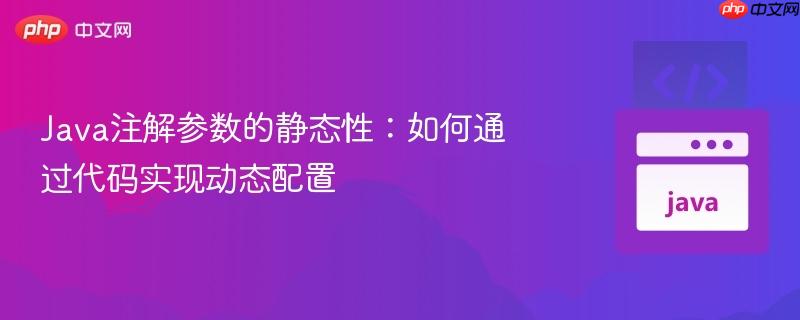
java注解的参数必须是编译时常量,这意味着它们无法直接从`application.properties`等外部配置文件中动态获取值。本文将深入探讨注解的这一核心限制,并提供多种实用的替代方案,如利用`@value`注入配置、结合aop实现条件逻辑以及通过spring的`@conditionalonproperty`控制组件生命周期,从而在运行时灵活地管理应用程序行为。
Java注解(Annotation)作为一种元数据,为代码提供了额外的信息,但它们并非设计用于运行时动态配置。注解的参数(也称为元素)在编译时就已经确定,并且必须是以下类型之一:
这意味着注解参数的值必须是常量表达式,不能是运行时才能确定的变量、方法调用结果或来自外部配置文件的值。因此,尝试直接将application.properties中的值注入到注解参数中是不可行的。例如,以下代码中的enable参数必须是一个布尔常量:
@Retention(RetentionPolicy.RUNTIME)
@Target(ElementType.TYPE)
public @interface PartyCacheable {
boolean enable() default false; // enable 必须是常量
}
@PartyCacheable(enable = false) // 这里的 false 必须是常量
public class PartyProcessing {
// ...
}如果希望根据application.properties中的party.cache.enable=true来动态控制PartyCacheable的行为,我们需要采用其他策略。
虽然注解参数不能直接动态化,但我们可以通过其他方式,在运行时根据外部配置来控制与注解相关的逻辑。以下是几种常用的方法:
立即学习“Java免费学习笔记(深入)”;
最直接的方法是将配置属性注入到你的业务逻辑类中,然后根据注入的值来决定是否执行特定行为。这种方法将动态性从注解本身转移到了业务代码的执行逻辑中。
示例代码:
import org.springframework.beans.factory.annotation.Value;
import org.springframework.stereotype.Component;
// application.properties
// party.cache.enable=true
@Component
public class PartyProcessing {
// 通过 @Value 将配置文件中的值注入到字段中
// ":false" 是默认值,如果配置文件中没有找到 party.cache.enable,则使用 false
@Value("${party.cache.enable:false}")
private boolean cacheEnabled;
public void processParty() {
if (cacheEnabled) {
System.out.println("缓存已启用:正在处理 Party 数据并使用缓存。");
// 执行缓存相关的逻辑
// 例如:从缓存中获取数据,如果不存在则查询数据库并放入缓存
} else {
System.out.println("缓存已禁用:正在处理 Party 数据,不使用缓存。");
// 执行不使用缓存的逻辑
}
// 核心业务逻辑
System.out.println("PartyProcessing 的核心业务逻辑执行中...");
}
// 假设有其他方法
public void anotherMethod() {
System.out.println("另一个方法执行中...");
}
}说明:
这种方法的优点是简单直观,直接在业务代码中控制逻辑流。缺点是如果有很多地方需要根据同一配置进行条件判断,可能会导致代码重复。
当动态控制的行为是一个横切关注点(cross-cutting concern),例如缓存、日志、事务等,并且希望通过注解来标记这些关注点时,AOP是一个非常强大的工具。你可以让注解作为一个纯粹的标记,而AOP切面则负责读取配置并决定是否执行相应的逻辑。
示例代码:
首先,定义一个简单的标记注解,不再包含enable参数:
import java.lang.annotation.ElementType;
import java.lang.annotation.Retention;
import java.lang.annotation.RetentionPolicy;
import java.lang.annotation.Target;
// 这是一个纯粹的标记注解
@Retention(RetentionPolicy.RUNTIME)
@Target(ElementType.TYPE) // 可以标记类或方法
public @interface PartyCacheable {
// 不再需要 enable 参数,AOP 会根据外部配置决定是否启用
}然后,创建一个AOP切面来处理带有@PartyCacheable注解的类或方法:
import org.aspectj.lang.ProceedingJoinPoint;
import org.aspectj.lang.annotation.Around;
import org.aspectj.lang.annotation.Aspect;
import org.springframework.beans.factory.annotation.Value;
import org.springframework.stereotype.Component;
// application.properties
// party.cache.enable=true
@Aspect // 标记这是一个切面
@Component // 让Spring管理这个切面
public class PartyCacheAspect {
@Value("${party.cache.enable:false}")
private boolean cacheEnabledFromProperties; // 从配置中获取缓存是否启用
// 定义一个环绕通知,作用于所有带有 @PartyCacheable 注解的类中的方法
// @within(com.example.PartyCacheable) 表示匹配被 @PartyCacheable 注解的类
// 也可以使用 @annotation(com.example.PartyCacheable) 匹配被 @PartyCacheable 注解的方法
@Around("@within(com.example.PartyCacheable)")
public Object applyCaching(ProceedingJoinPoint joinPoint) throws Throwable {
if (cacheEnabledFromProperties) {
System.out.println("AOP: 缓存功能已启用。正在执行缓存逻辑...");
// 可以在这里实现实际的缓存逻辑
// 例如:检查缓存中是否有数据,如果有则直接返回,否则调用原始方法并缓存结果
Object result = joinPoint.proceed(); // 执行原始方法
System.out.println("AOP: 缓存逻辑执行完毕,结果已缓存。");
return result;
} else {
System.out.println("AOP: 缓存功能已禁用。直接执行原始方法。");
return joinPoint.proceed(); // 直接执行原始方法,不进行缓存处理
}
}
}最后,在你的业务类上使用这个标记注解:
import org.springframework.stereotype.Component;
@PartyCacheable // 标记这个类可能需要缓存处理
@Component
public class PartyProcessing {
public void processParty() {
System.out.println("PartyProcessing.processParty() 核心业务逻辑执行中...");
// 实际的业务逻辑,不包含缓存判断
}
}说明:
这种方法将业务逻辑与横切关注点分离,使得代码更加模块化和易于维护。注解本身保持了其元数据标记的纯粹性。
如果你的需求是根据配置属性来决定是否加载或创建某个Bean(即整个组件的启用/禁用),那么Spring Boot提供的@ConditionalOnProperty注解非常适用。
示例代码:
import org.springframework.boot.autoconfigure.condition.ConditionalOnProperty;
import org.springframework.context.annotation.Bean;
import org.springframework.context.annotation.Configuration;
import org.springframework.stereotype.Component;
import org.springframework.beans.factory.annotation.Autowired;
import org.springframework.beans.factory.annotation.Qualifier;
// application.properties
// party.cache.enable=true
// 定义一个缓存服务接口和实现
interface CacheService {
void cacheData(String data);
String retrieveData(String key);
}
@Component("partyCacheService") // 默认实现,可能是不缓存的
class NoOpCacheService implements CacheService {
@Override
public void cacheData(String data) {
System.out.println("No-op Cache: Not caching data: " + data);
}
@Override
public String retrieveData(String key) {
System.out.println("No-op Cache: Not retrieving data for key: " + key);
return null;
}
}
// 真正的缓存服务实现,只有当配置启用时才会被创建
@Component("partyCacheService") // 同样命名为 partyCacheService
class RealPartyCacheService implements CacheService {
@Override
public void cacheData(String data) {
System.out.println("Real Cache: Caching data: " + data);
// 实际的缓存逻辑,例如存入Redis或Ehcache
}
@Override
public String retrieveData(String key) {
System.out.println("Real Cache: Retrieving data for key: " + key);
// 实际的缓存获取逻辑
return "CachedValueFor" + key;
}
}
@Configuration
public class CacheConfig {
// 当 party.cache.enable=true 时,创建 RealPartyCacheService bean
// matchIfMissing = false 意味着如果 party.cache.enable 属性不存在,则不匹配条件
@Bean
@ConditionalOnProperty(name = "party.cache.enable", havingValue = "true", matchIfMissing = false)
public CacheService realPartyCacheService() {
return new RealPartyCacheService();
}
// 当 party.cache.enable != true 或属性不存在时,创建 NoOpCacheService bean
// This bean will be created if the 'realPartyCacheService' bean is NOT created.
// We can't use @ConditionalOnMissingBean directly if RealPartyCacheService is also @Component
// A more robust way might be to only define NoOpCacheService if real is not present
// For simplicity, let's assume if realPartyCacheService is not created, NoOpCacheService will be used
// If both are @Component with same name, Spring might have issues.
// A better approach is to make NoOpCacheService the default and conditionally replace it.
// Let's modify to ensure only one is active.
@Bean
@ConditionalOnProperty(name = "party.cache.enable", havingValue = "false", matchIfMissing = true) // If property is false or missing, use no-op
public CacheService noOpCacheService() {
return new NoOpCacheService();
}
}
@Component
public class PartyProcessing {
// 注入 CacheService,Spring会根据条件注入 RealPartyCacheService 或 NoOpCacheService
private final CacheService cacheService;
// 构造器注入
public PartyProcessing(@Qualifier("realPartyCacheService") @Autowired(required = false) CacheService realCacheService,
@Qualifier("noOpCacheService") @Autowired(required = false) CacheService noOpCacheService) {
if (realCacheService != null) {
this.cacheService = realCacheService;
} else if (noOpCacheService != null) {
this.cacheService = noOpCacheService;
} else {
// Fallback if neither is created (shouldn't happen with the current setup if one is always created)
this.cacheService = new NoOpCacheService(); // Default to no-op
}
}
public void processParty(String partyId) {
String cachedData = cacheService.retrieveData("party:" + partyId);
if (cachedData == null) {
System.out.println("Party " + partyId + " not in cache. Fetching from source...");
String data = "PartyDataFor" + partyId; // 模拟从数据库获取数据
cacheService.cacheData(data); // 尝试缓存数据
System.out.println("Processing Party " + partyId + " with data: " + data);
} else {
System.out.println("Party " + partyId + " found in cache: " + cachedData);
System.out.println("Processing Party " + partyId + " with cached data.");
}
}
}说明:
这种方法适用于在整个组件级别进行动态启用/禁用,例如根据环境选择不同的数据源、消息队列客户端或缓存实现。
通过上述方法,你可以在保持注解作为元数据标记的纯粹性的同时,有效地实现基于外部配置的动态应用程序行为。
以上就是Java注解参数的静态性:如何通过代码实现动态配置的详细内容,更多请关注php中文网其它相关文章!

每个人都需要一台速度更快、更稳定的 PC。随着时间的推移,垃圾文件、旧注册表数据和不必要的后台进程会占用资源并降低性能。幸运的是,许多工具可以让 Windows 保持平稳运行。

Copyright 2014-2025 https://www.php.cn/ All Rights Reserved | php.cn | 湘ICP备2023035733号